Month: November 2022
Arty Shock Wave

We do the wrong thing when we don’t know any better, but then thinking critically about how our decisions resulted in an undesirable outcome and making a plan for how to achieve a better outcome the next time is the map to improvement. Perhaps the only thing better than learning from your own mistakes is learning from someone else’s. Let’s get into five common mistakes that we aren’t going to make this year, and will all be better for it.

DON’T HIDE BEHIND TREES
We tend to think of the world the way we experience it as humans. That’s why we are hyper-focused on making sure animals don’t see us. I’m no different. I am careful to make sure I am using the best camouflage available, cover my face, and never cross a ridge on the skyline. As a young hunter, I was always seeking concealment behind the brush, rocks, trees, etc. I am thankful that I’ll never know how many critters got close to me without me ever seeing them because I can’t see through trees in the same way that I can’t be seen through trees.

On a high desert peak in central Nevada, my good buddy Adam Hutchison and I spent a week hunting mule deer with a long bow. We had the basic pattern of the bucks nailed down after a few days. In the morning they’d graze on one side of the ridge until it got warm then bed down on the shady side until evening when they’d cross again to graze.
One evening we watched an ancient old 4×4 get out of his bed beneath a juniper tree and start working his way towards a pass in the ridge with a prominent game trail going through it. I stayed in place and watched through my spotting scope and Hutch scrambled off our knoll and positioned himself behind a short thick piñon pine that had been stunted by relentless Nevada winds. The tree itself might not have been more than 8’ tall but the trunk and limbs spread out to make an area that was around 15’ across.
The buck climbed along steadily into the pass as Hutch waited with an arrow knocked. I could see the wind pick up small puffs of dust as the buck walked, a wind blowing at the deer’s back, and just knew Hutch was going to get a shot. The old buck walked straight to pine, opposite where my buddy stood. They both waited there a long time, spread by no more than 6 yards. At the same time as Hutch took a step to walk around the tree counterclockwise, the buck did the same thing, also counterclockwise.
They mirrored each other as they walked around the tree, 180 degrees apart, both vaguely aware of the other but neither confident enough to make a bolder move. When the buck got to where Hutch had been standing and could smell his scent on the ground he bolted and we never saw him again.
Good camo breaks up your outline and blends into the background. If you stand in front of a tree, your camo will do its job and you’ll have excellent visibility of animals approaching and a full range of motion to draw a bow or shoulder a rifle. Try to pick locations where an animal will have to pass behind objects that will allow you the chance to move if you need to.

DON’T GLASS TOWARDS THE SUN
Spot and stalk hunting requires a lot of time spent glassing. When I scout an area, even more important to me than finding animals is finding good places to glass from. I want different glassing locations for different times of day, but above all I do not want to glass East in the morning or West in the evening. At first and last light, deer and elk will glow in the low angle sunlight and are very easy to spot if the sun is at your back. If it’s in your face it will flare out your lens and you’ll be fighting to tell trees from rocks.
During morning glassing sessions I like to take inventory of who is in the area and where they go to bed. Depending on the situation I can then make a mid-day move or be in a good position for the evening. During evening glassing sessions I tend to put myself much closer to the zone I am glassing so I can get into position and make a shot, especially if I am rifle hunting. With a bow, I tend to work towards situations where I will be shooting in the morning to give myself max daylight hours for blood trailing and getting meat hanging.
During an especially bad fire year, I hiked two days into the wilderness to get to a spot I just knew was going to hold deer. I made an especially difficult climb onto a glassing knoll that looked into a basin and settled in about 2 pm. The fires puffed up as they tend to in the afternoons and my basin grew hazy with smoke. I could still glass so I wasn’t bothered by it.
As the sun headed towards the horizon and the color of the light warmed, the smoke picked up that color and became impossible to glass through. My entire hunt depended upon being able to glass from this knob, and if I’d spent 30 seconds thinking about the light and air conditions during my two-day hike into that location I would’ve come up with a much better plan. As it was, I committed to the spot, and after three days of not being able to see, I hiked out empty-handed feeling dumb.

WAIT FOR THERMALS TO STABILIZE
When the ground is cooler than the air, it causes air to settle in a way that makes the wind begin blowing downhill. As the ground heats from solar gain in the morning and becomes warmer than the air, it causes lift that makes wind blow uphill. Animals base their movements, feeding locations, and when/where they bed on these diurnal wind conditions. However, there are transition times when the thermals are switching that you get periods of uphill wind followed by downhill followed by uphill again.
I’d been guiding a group of gentlemen from the East Coast on a backcountry elk hunt in the alpine for a week. We had seen and smelled elk but not many and weren’t able to get them to engage with calls and couldn’t navigate the steep country well enough to maneuver on them, so we headed to a different area that was short grass prairie interspersed with canyons, the north sides of which had timber. We glassed up a herd of around 70 elk with a great 6-point bull and watched them come off a south-facing ridge and settle into a north.
It was going to be an easy approach and I was fully confident we could challenge that bull into archery range. At 8:30 am I felt a puff of wind come uphill and grabbed the hunters and headed into the north. As soon as we got into the trees I could immediately feel the coolness and stopped. Then that dreaded feeling of cold sweat on the back of my neck made colder by a downhill thermal rippled through me and the scent carried on down into the trees and 70 head of elk got up at 150 yards and thundered off, ending our hunt. There was no rush, those elk were going to sleep in that north all day long.
We could’ve taken a nap and waited until 10 am for some really stable wind conditions and slipped into calling range and gotten that bull so mad he’d be willing to fight, but I rushed the thermals and blew it. Lesson learned.

DON’T OVERSHOOT THE WIND
We seek comfort and efficiency naturally because those are survivable conditions. If you are anything like me, you enjoy going out to the range on days with pleasant weather. I can settle into a bench with my rifle on a bipod and shooting bag and hit targets at will. Even if the wind kicks up a little, I know my rifle range and can tell the difference between a 9mph wind and a 12 mph wind and I know how a three o’clock at the bench turns into a 5 0’clock at 500 yards. I know this because I’ve shot there a lot. The odds of getting to practice in the location you’ll be shooting in a hunting scenario are so low it’s not even worth talking about.
Here’s my point, the wind is doing something on the terrain you are hunting in that you don’t fully understand. Learning and reading wind takes a lot of trial and error. As the earth tilts on its axis during fall it causes massive shifts in weather patterns. The decreased daylight hours and even the change of color on foliage all play a role in fall weather. There is a much higher chance you are going to shoot through storm-driven winds which are also being influenced by diurnal terrain-driven thermal winds. Just because you could hit your target on your home rifle range at 600 yards every time in July doesn’t mean you can do it on the mountain. Take your maximum effective range in practice and reduce it for hunting.

I missed three consecutive shots, prone, with a shooting bag, on a target at 505 yards at the Sig Hunter Games in Wyoming this year. The wind was blowing between 10-15 mph at 6 o’clock from the shooting location, and around 20mph from 9 o’clock from 150-350 yards, and then who knows how fast at 7 o’clock from 350-500. Whiffed three times in a row. I shot the same target the day before with half that wind and went three for three. I don’t take 500-yard shots when hunting big game for this exact reason. I can’t guarantee a precise hit.

DON’T SHOOT TOO MUCH BOW OR GUN
This has got to sound weird coming from me, and a younger version of myself would be rolling his eyes right now. Recoil is a real thing. If you don’t believe you are affected by recoil, the next time you go out to the range get in a contest with your buddy who shoots as well as you and see who can shoot a tighter group at 30 yards. You get to use your hunting rifle, and he gets to use a 22lr. I’ve played this game with guys who are much better shots than me and if I have the 22, I win. I have had a ton of clients show up with rifles that had too much recoil and they couldn’t shoot them well. Same thing with bows. The times I have turned down the draw weight for clients they have always shot better. Take the indoor archery shooters as an example, you know, the guys you see lined up in Vegas shooting half-inch dots over and over and over again from the 20-yard line. How many of them are drawing 80lbs? Zero. 70lbs? Zero
Do I shoot an 80lb bow? I used to. Right now I am pulling 70 and shooting better than I have in a decade. Will I shoot 80 again? Maybe, but only if I can shoot it well enough to satisfy my own accuracy requirements. I’d rather see a client shoot a smaller rifle well or a lighter draw weight bow more accurately than a heavy-hitting contraption that scares them into shooting poorly. Fun fact: If you turn your bow’s draw weight down and increase your arrow weight, you can get the same penetration you had before.
I’m not telling you to run out and buy a new gun. You can reduce recoil on the rifle you have by adding a suppressor, making the gun heavier by adding accessories, or by changing the stock or barrel, or adding a muzzle brake. I despise muzzle brakes and ask that clients do not bring them, but they are a relatively inexpensive way to reduce recoil. Just make damn sure that you and everyone around you are wearing good ear protection and don’t shoot it across the hood of a pickup. If you do decide to buy a new rifle, getting one with an adjustable stock will go a long way toward making the shooting experience more pleasant.
The best way to learn any of this is to not take my word for it and go out and make these mistakes yourself. Like the drill instructors enjoy saying, “pain retains.” The most efficient way? Well, that’s to let my mistakes be your lessons.
I’d love to learn from your hunting mistakes, so if you’ve ever made one, write it in the comment section at the bottom of this article. Let’s learn from each other and improve together.

Certain names are indelibly burned into the foundations of the modern gun world. Kalashnikov made a few rifles, while Stoner’s radical black gun has ably served American troops for more than half a century. And you might have heard of a certain fellow named John Moses Browning. But we must not forget about Georg Luger.
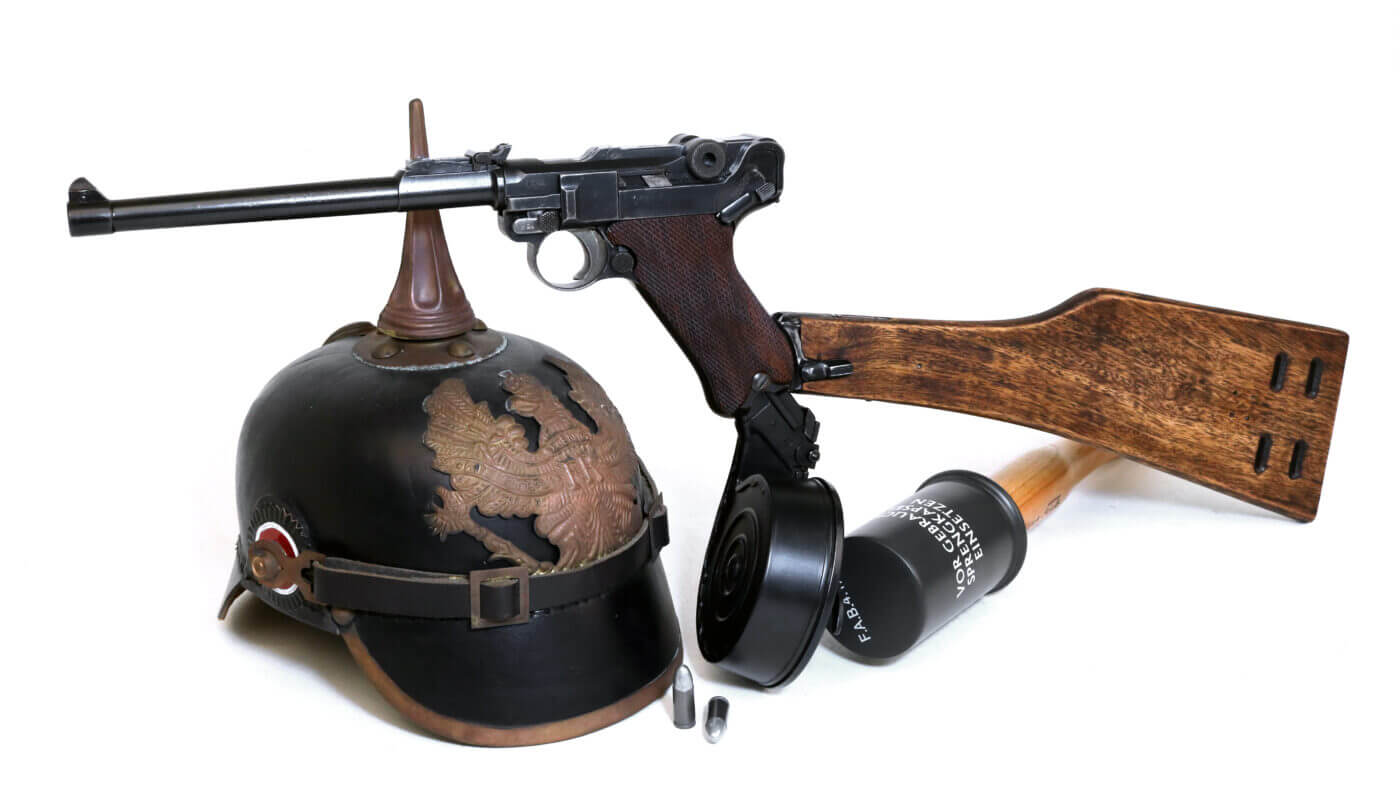
Towering Teuton
Georg Johann Luger was born in 1849 in Steinach am Brenner, Tyrol, and raised in Italy. He was trained as an accountant. Luger volunteered for military service in 1867 and found that he had a knack for marksmanship. This awakened a latent gift for firearms design.
While in the employ of Ludwig, Loewe, and Company, Georg travelled to the United States in 1894 to demonstrate the radical Borchardt-Selbstladepistole C-93 to the U.S. Army. Uncle Sam had little interest in the complex and finicky Borchardt gun, but Herr Luger came home with their documented criticisms prepared to do better. Using the C-93 Borchardt as a starting point, Luger crafted the improved Parabellum pistol that he successfully patented in 1898.
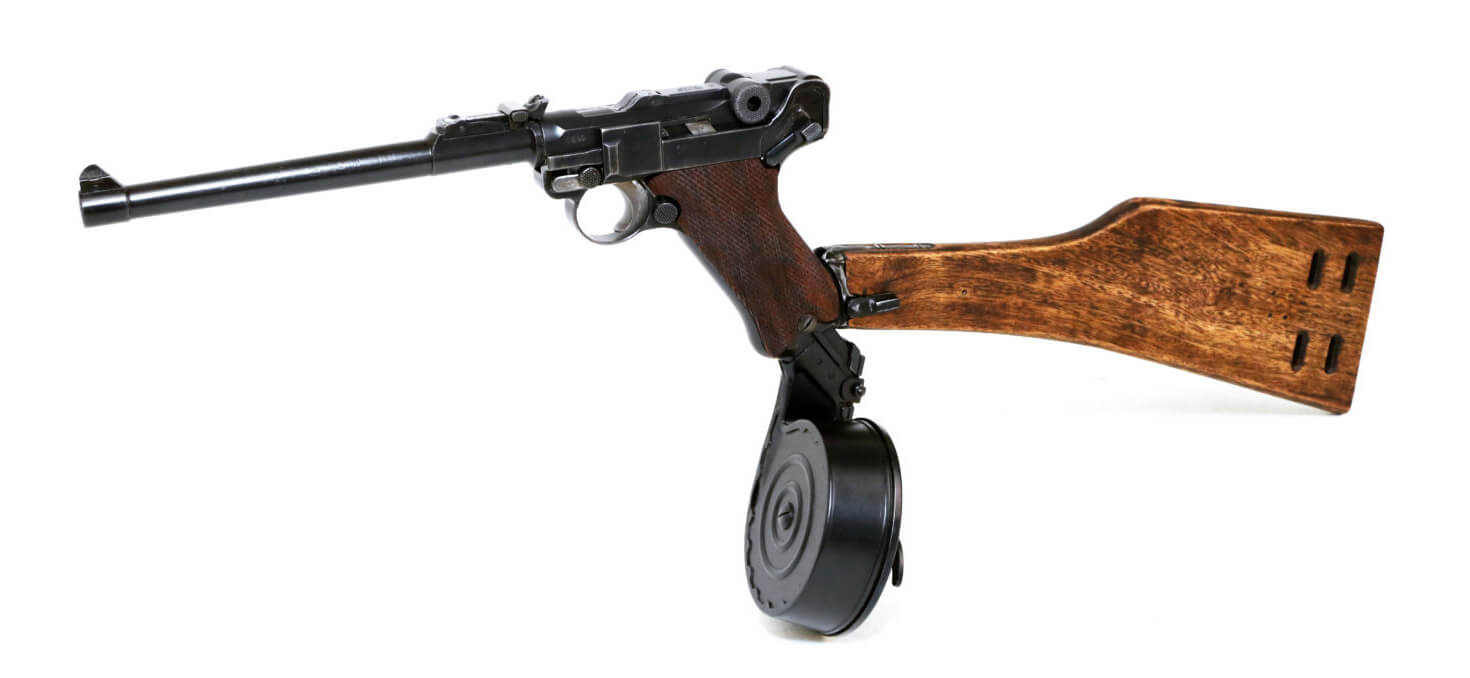
While Herr Luger was working on his Parabellum pistol he also designed the 9x19mm cartridge it typically fired. This modest rimless round ultimately became the most produced handgun cartridge in human history. Modern bullet design has made the 9mm the world’s most common defensive pistol round even more than a century after its introduction. Not bad for a guy trained in accounting.
Switzerland was the first military customer for Luger’s radical Parabellum pistol in 1900. The Kaiser’s Navy bought the gun in 1903. The German Army followed suit in 1908.
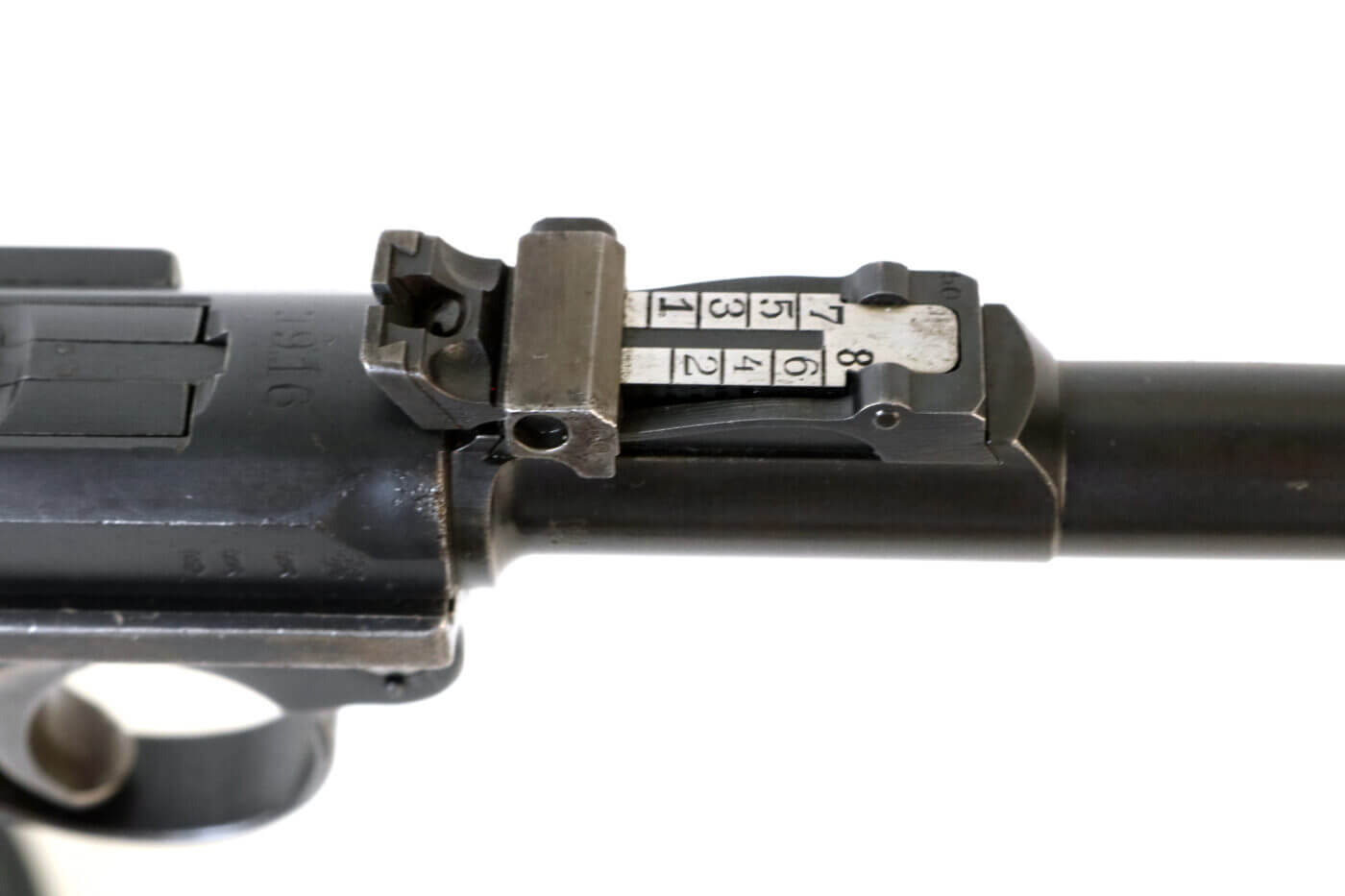
The Parabellum pistol briefly had a shot at becoming the standard U.S. Army combat handgun. In 1907, Herr Luger provided a pair of Parabellum pistols chambered in .45 ACP along with 746 handloaded .45 ACP cartridges to compete against the 1911 and Savage offerings. Luger eventually pulled his guns, and the 1911 obviously won the day. That first .45 ACP Luger was purportedly destroyed during testing. The second is supposedly in private hands today and is potentially the most valuable collectible handgun on the planet.
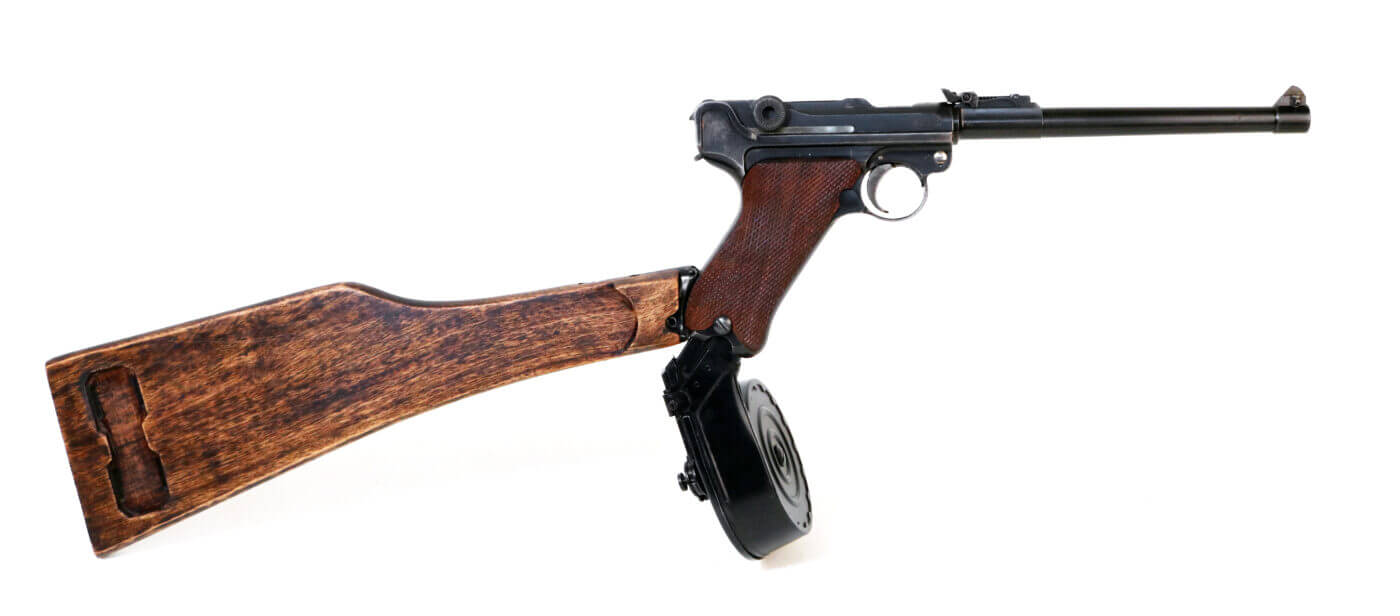
A Specialist’s Weapon
In July of 1913, the Kaiser himself authorized the development of the Lange Pistole 08, or LP08. The new design effort was spearheaded by a German Army officer named CPT Adolf Fischer. This modified Parabellum pistol sported a 7.9″ barrel, an eight-position ramp-adjustable rear sight and a detachable board-type shoulder stock. The world came to know the LP08 as the Artillery Luger.
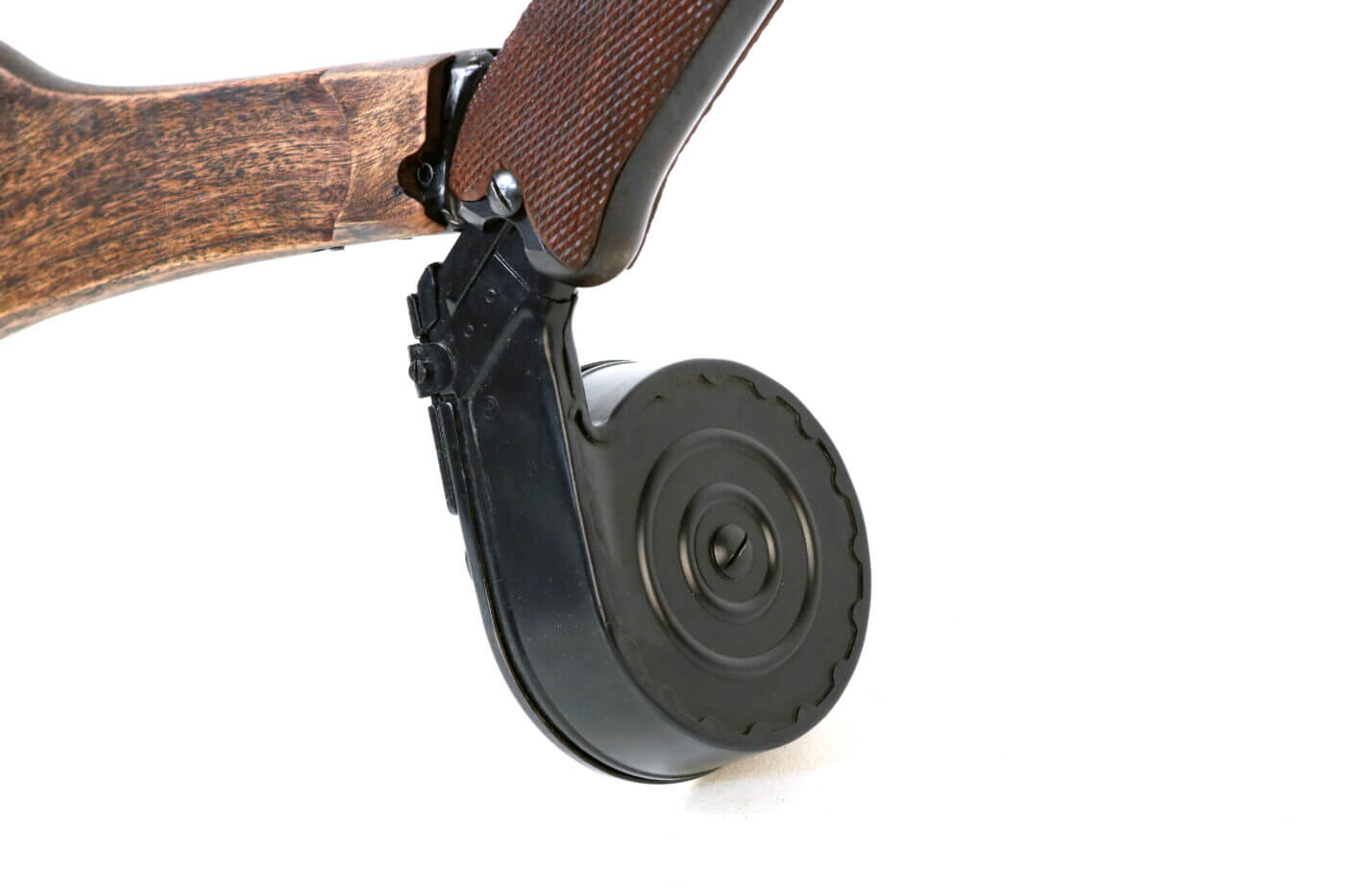
The Artillery Luger was an amazing piece of work. The rear sight, for instance, incorporates a cam mechanism that moves the assembly left as the unit is elevated to compensate for spin drift of the 9mm round at long ranges. That’s pretty ridiculous given that this round drops 35 feet at 500 meters, but it is mechanically fascinating, nonetheless.
The Artillery Luger draws its name from its intended mission. Artillery crews had their hands full servicing their field pieces and required a compact weapon that wouldn’t interfere with their primary duties. Should their positions be threatened, however, they could bring their little Luger carbines into action in the close fight.
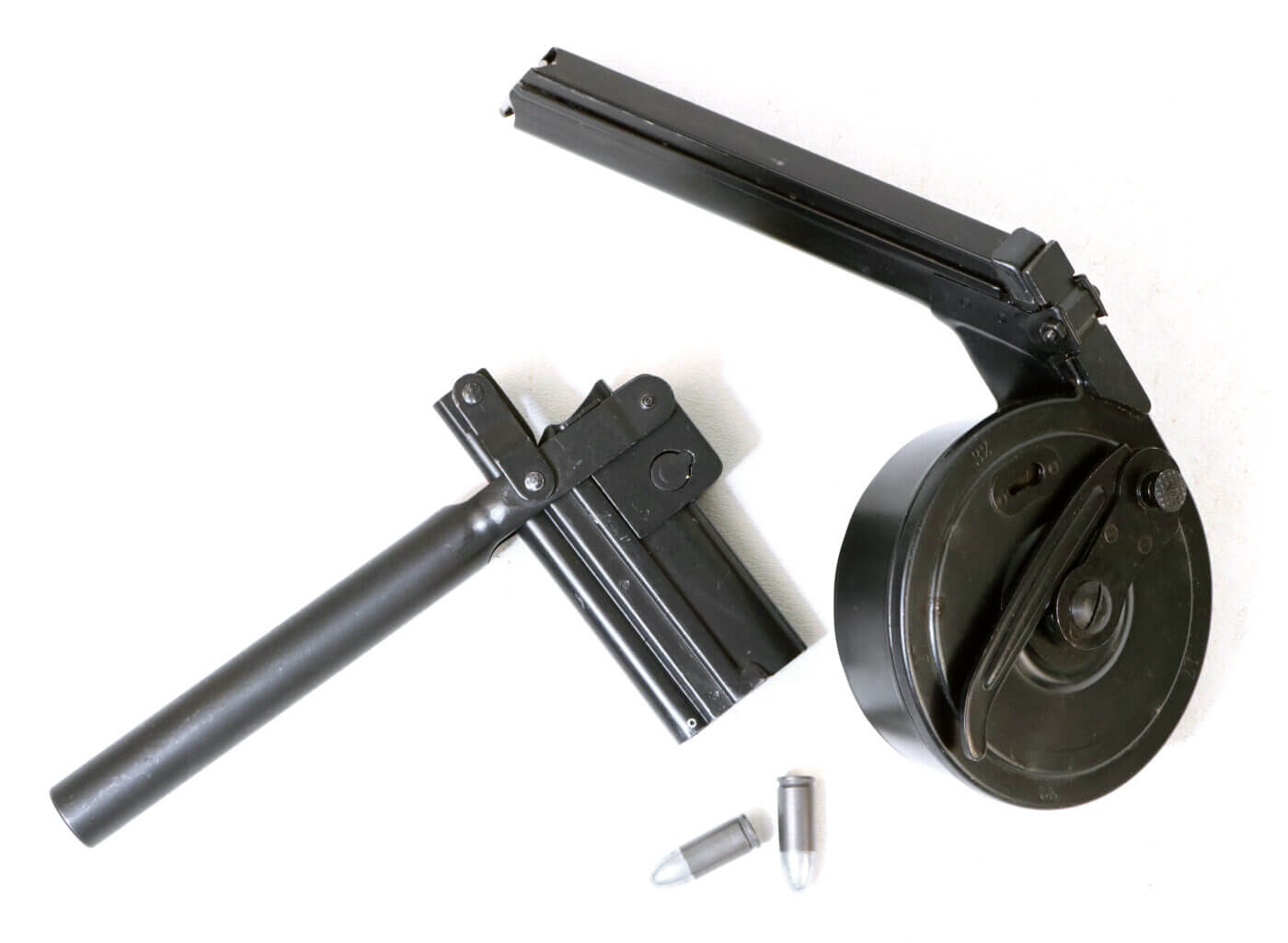
The Artillery Luger came equipped with a complicated 32-round snail drum called the Trommelmagazin that substantially enhanced the gun’s onboard firepower. The Trommelmagazin was effective enough in action, but it required a dedicated loading tool that was almost as complex as the magazine itself.
Artillery Lugers were typically issued along with a wooden storage box called a P-Kasten. This case carried five drum magazines as well as the magazine loader and twelve boxes of ammunition. Complete versions of this kit are rarer than honest politicians these days.
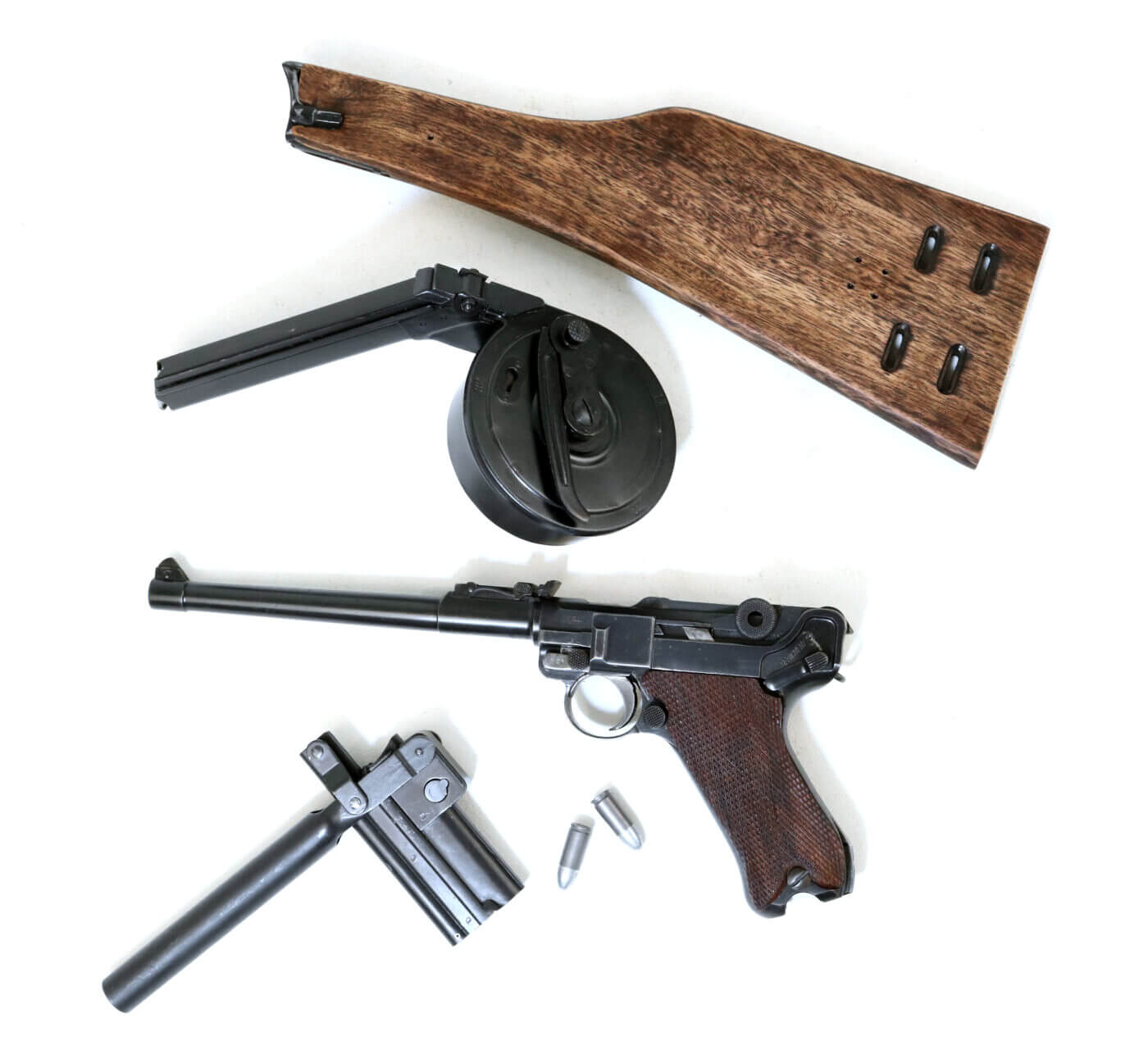
The resulting nifty little carbine caught the eye of lots of folks other than artillerymen. Before Antony Fokker perfected his synchronization gear allowing belt-fed machineguns to fire through a propeller arc, Artillery Lugers were sought after by early German aviators. The Germans actually conducted tests to determine if the 9mm Parabellum round was effective when fired against a running aeroplane engine (it wasn’t terribly).
The Lange Pistole also saw widespread use by the Imperial Stormtroopers who specialized in close quarters operations later in the war (to learn more about “Trench Raiders” of World War I, click here). The weapon’s compact dimensions made maneuvering among hostile trenches an easier chore than might be the case with a full-sized infantry rifle. Waffen SS troops even used the Artillery Luger in a limited fashion during the Second World War as well.
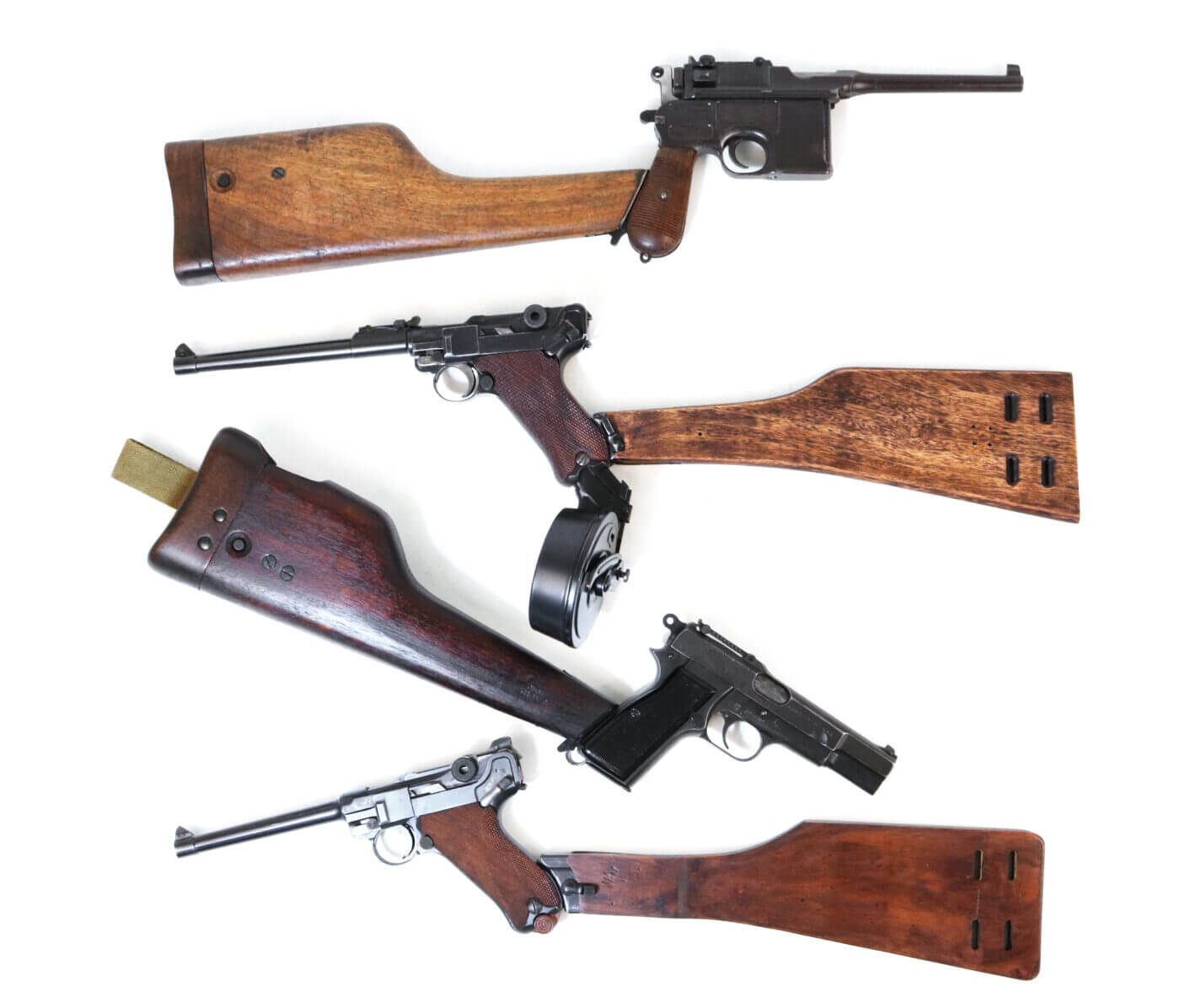
A Sprinkling of Human Anatomy
You can take an unloaded example of Georg Luger’s Parabellum pistol, press the muzzle against a firm surface, and observe the man’s inimitable genius. The action was inspired by the mechanics of the human knee. A recoil-driven design, as the barrel assembly cycles backwards upon firing the cam built into the frame pitches the toggle up and open, with the force required to “bend the knee” keeping the action closed long enough for safe operation.
This movement unlocks the gun’s bolt and allows it to cycle backwards to extract and eject a spent case. A coil spring in the butt shoves everything forward again to repeat the sequence. The exposed nature of the design left it susceptible to battlefield grime, but the gun was nonetheless a revolutionary advance over the revolvers against which it competed during its development.
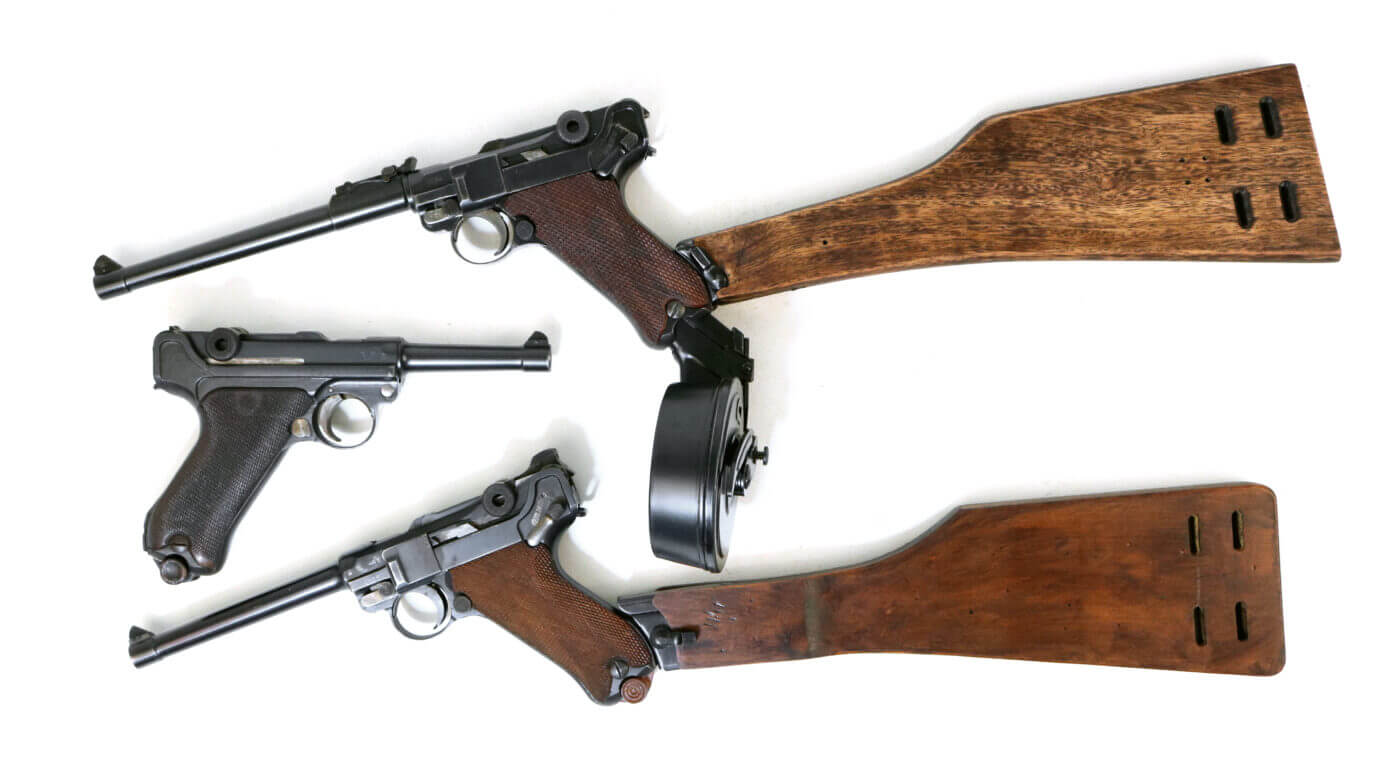
Practical Tactical
The magazine release on the Parabellum pistol is underneath the right thumb where it should be, and the toggle action is comparably accessible with either hand. The safety is a thumb lever on the left. Forward is fire. Magazines do not typically drop free but do include a dimpled wooden floorplate to aid their extraction.
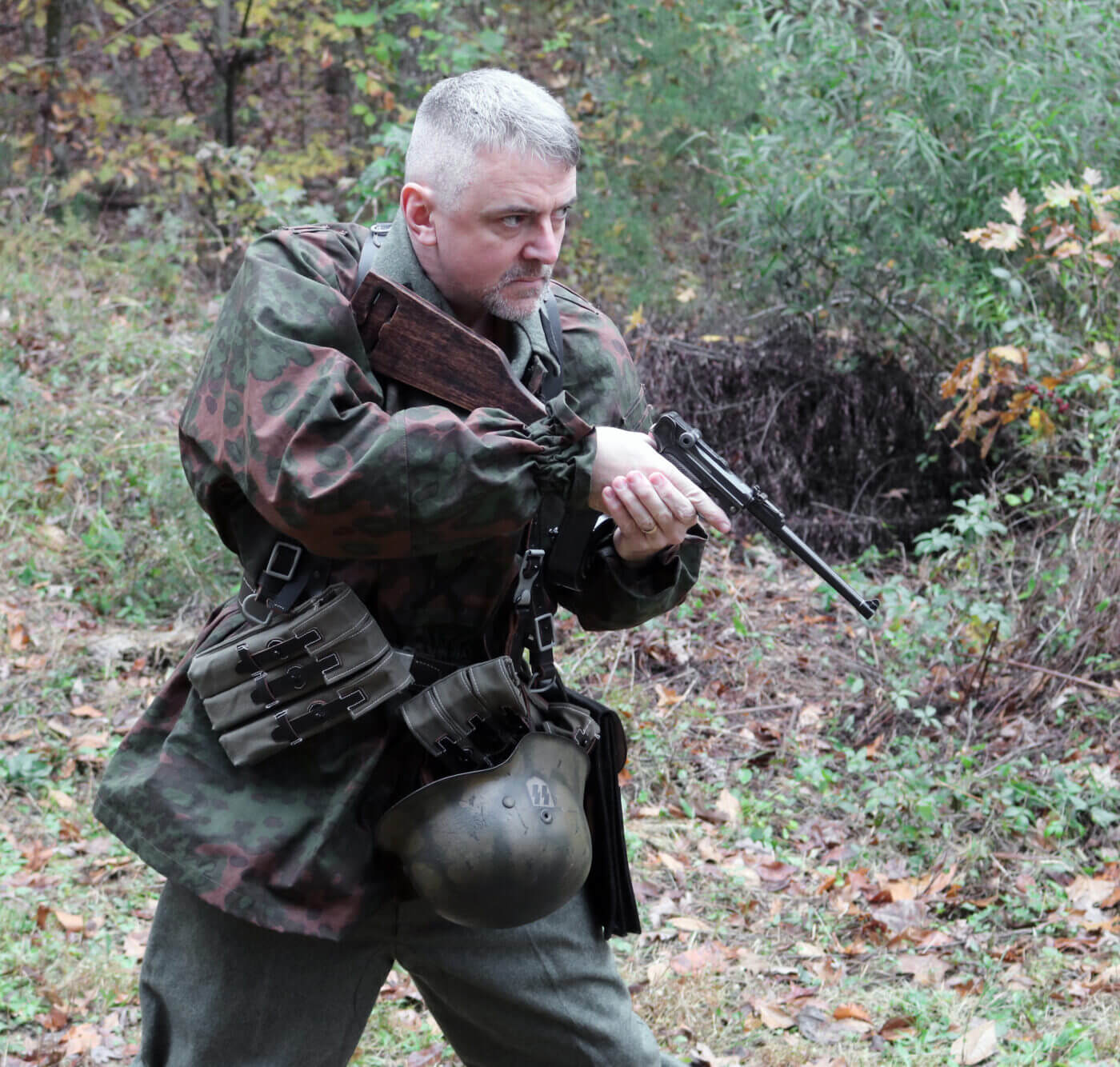
The assembled rig is fairly awkward, but it would still beat its competition in the trenches by a wide margin. While with the benefit of hindsight the Artillery Luger seems more like spy kit than an infantry combat weapon, it was an evolutionary stepping stone to later, greater things. The LP08 Artillery Luger is indeed a First World War icon.
Special thanks to www.worldwarsupply.com for the cool replica gear used in our photographs.

A policy proposal heading for Board of Supervisors approval next week would explicitly authorize San Francisco police to kill suspects using robots.
The new policy, which defines how the SFPD is allowed to use its military-style weapons, was put together by the police department. Over the past several weeks, it has been scrutinized by supervisors Aaron Peskin, Rafael Mandelman and Connie Chan, who together comprise the Board of Supervisors Rules Committee.
The draft policy faces criticism from advocates for its language on robot force, as well as for excluding hundreds of assault rifles from its inventory of military-style weapons and for not including personnel costs in the price of its weapons.
Peskin, chair of the committee, initially attempted to limit the SFPD’s authority over the department’s robots by inserting the sentence, “Robots shall not be used as a Use of Force against any person.”
The following week, the police struck out his suggestion with a thick red line.
It was replaced by language that codifies the department’s authority to use lethal force via robots: “Robots will only be used as a deadly force option when risk of loss of life to members of the public or officers are imminent and outweigh any other force option available to SFPD.”
This could mark a legal crossing of the Rubicon for the city: Robot use-of-force has never before been approved, nor has it ever been prohibited, in San Francisco. A version of this draft policy was unanimously accepted by the rules committee last week and will come before the full board on Nov. 29.
“The original policy they submitted was actually silent on whether robots could deploy lethal force,” said Peskin. He added that he decided to approve the SFPD’s caveated guidelines because the department had made the case that “there could be scenarios where deployment of lethal force was the only option.”
Advocates and lawyers who oppose the militarization of the police are less convinced.
“We are living in a dystopian future, where we debate whether the police may use robots to execute citizens without a trial, jury, or judge,” said Tifanei Moyer, senior staff attorney at the Lawyers’ Committee for Civil Rights of the San Francisco Bay Area. Moyer leads the organization’s work on police misconduct and militarization.
“This is not normal,” she wrote over email. “No legal professional or ordinary resident should carry on as if it is normal.”

The SFPD has 17 robots in its arsenal, 12 of which it describes as fully functional. According to police spokesperson Officer Robert Rueca, they have never been used to attack anyone. The robots are remote-controlled, and are typically used to investigate and defuse potential bombs or to surveil areas too awkward or dangerous for officers to access.
Uses defined in the new draft policy include “training and simulations, criminal apprehensions, critical incidents, exigent circumstances, executing a warrant or during suspicious device assessments.”
And, in extreme circumstances, they can be used to kill.
How are robots used lethally?
In 2016, the Dallas police force strapped plastic explosives to a robot and used it to blow up a sharpshooter who had killed five officers, in the first U.S. instance of a police robot killing a suspect. One of the SFPD’s robots, the Remotec F5A, is the same model as the one used by Dallas police.
More recently in Oakland, a policy on lethal robots came before the city’s police department’s civilian oversight council. One device they discussed was the PAN disruptor, a device that can be attached to a remote-controlled robot and uses a blank shotgun shell to disable a bomb by blasting it with pressurized water. Oakland police acknowledged that, in emergencies, they could arm it with live rounds. The SFPD also has multiple PAN disruptors that can be attached to robots and fire shotgun shells.
Last month, Oakland police ultimately backed down and removed language that would have allowed them to kill using robots. They said they hope to pursue the option in the future.
Rueca said that the San Francisco Police Department “does not have any sort of specific plan in place” for how lethal force would be applied with robots as “the unusually dangerous or spontaneous operations where SFPD’s need to deliver deadly force via robot would be a rare and exceptional circumstance.”
Why is this happening now?
Cities across California are currently drafting new policies on the use of military weapons by local police forces, thanks to a state law called AB 481, which passed last year. Figuring out the force options of robots is one small part of the law’s remit.
The law mandates that every police force in California must annually report its stock of all military-style weapons, their cost, how they can be used, and how they were deployed in the prior year. The law gives local authorities — in San Francisco’s case, the Board of Supervisors — the ability to annually reject or accept the rules governing how the weapons are used.
The Board will also be required to sign off on any new military-style equipment before purchase, although the police will be able to replace any existing equipment up to a value of $10 million without approval.

Most advocates opposed to the militarization of the police hail AB 481 as a step in the right direction for accountability and transparency. But concerns have been raised that some jurisdictions have not gone far enough in limiting how military-style weapons can be used.
Jennifer Tu, a fellow with the American Friends Service Committee, has been tracking how police departments across the state are implementing AB 481.
“My suspicion is that most policies will have left room for robots to use force,” said Tu. She said that it was her understanding that most departments have not mentioned robots at all, which means they are subject only to generic restrictions.
The ACLU has published advice on the use of robots by police, and notes that the limited situational awareness of robots, compared to in-person officers, make it more likely that force is “used inappropriately and/or on the wrong targets.”
“There is a really big difference between hurting someone right in front of you, and hurting someone via a video screen,” said Tu.
What else is in the draft policy?
Tu contended that, on top of the issue of robot force, there are other problems with San Francisco’s draft policy, as it currently stands.
In its initial submission, the SFPD omitted all of its 608 semi-automatic assault rifles, 64 machine guns, and 15 submachine guns from the new use-of-force policy. According to Peskin, these were added in when he pushed back on their omission. But in the department’s latest version, which is set to come before the supervisors next week, 375 of the semi-automatic assault rifles are missing again.
The rationale given for the removal of these assault rifles from the policy: The Chief of Police defines them as “standard-issue service weapons.”
Others disagree with that assessment. “We don’t see regular officers walking around with assault rifles,” said Allyssa Victory, staff attorney with the criminal justice program at the ACLU of Northern California (and recent Oakland mayoral hopeful). “Just writing a policy doesn’t make it so.”
Victory added that shotguns and handguns can be omitted because they are standard issue, according to AB 481, but no such exemption applies to assault rifles.
“The law defines ‘military weapons,’ not the chief of police,” wrote civil rights lawyer Moyer over email. “San Francisco is not the only department to attempt to redefine ‘military weapons’ so as to justify hiding their use, costs, and upkeep from the public.”
“If the law defined military weapons as bubble gum, then the police department would have to disclose their use of bubble gum,” she wrote.
Tu added, “I really think it is confusing to the public if we don’t have those assault weapons reported.” Their omission would mean that in future annual reports, the police would not need to declare how the guns had been used or who had been injured by them.
Another point of contention with advocates is that the SFPD has not included personnel training or maintenance times in their valuation of the cost of their military-style weapons. This appears to be required by AB 481, which states that costs must include “acquisition, personnel, training, transportation, maintenance, storage, upgrade, and other ongoing costs” of the weapons.
But the SFPD rejected a suggestion from the American Friends Service Committee to include personnel costs. The department said that maintenance and training occur during normal work hours, and that their human resources management system cannot track different types of work done by officers, so “there is no compelling reason to track in the suggested manner.”
It remains to be seen if the policy, as it stands, will be approved by the Board of Supervisors, and what limitations will ultimately be placed on the police department’s military-style weapons, including its robots. And, once the rules are settled, the process will begin again with the Sheriff’s Department, which will need to create its own policy to stay in compliance with AB 481.
“The great news about this thing is that it can be evolved,” said Peskin, adding that policy must be scrutinized and approved every year if the SFPD wants to keep using its weapons.
“And I think we are starting off in a good place.”
This policy will be discussed at the Board of Supervisors meeting on Tuesday November 29. The meeting starts at 2 p.m. and the police equipment policy is agenda item 28. More details can be found in the full meeting agenda.
.jpg)

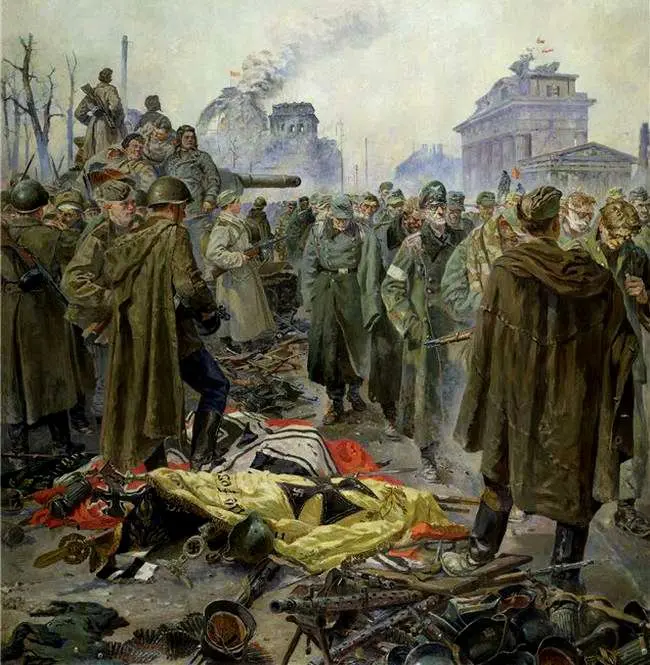
Pity that this was not Patton’s 3rd Army but it turned out okay in the long run! (Except for all the German women that were raped by the Russians as their “reward” given by Stalin) Grumpy
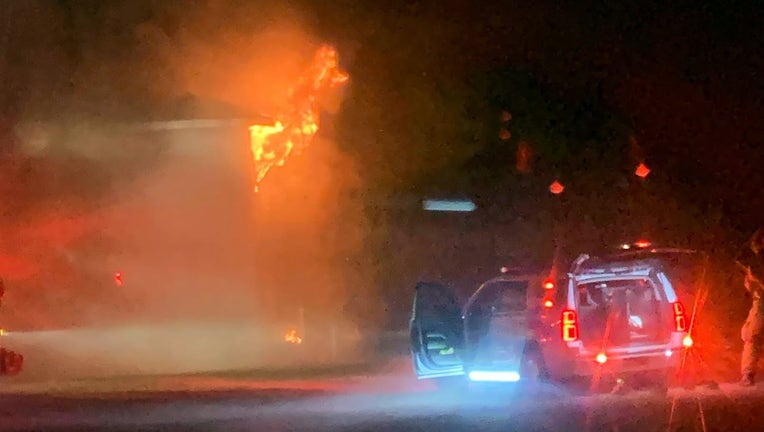
Salisbury Fire Department photo
SALISBURY, Maryland – Firefighters in Maryland say an 11-year-old boy suffered minor burns after racing back into a burning apartment building to rescue his 2-year-old sister.
The blaze broke out Tuesday evening on the second floor of a two-story apartment building in Salisbury, which is in Maryland’s Eastern Shore.
According to the state fire marshal’s office, the boy fled the building when smoke alarms started going off, but then he realized his sister was still inside. That’s when he went back up to the burning second floor to rescue her, suffering a minor burn to his arm in the process.
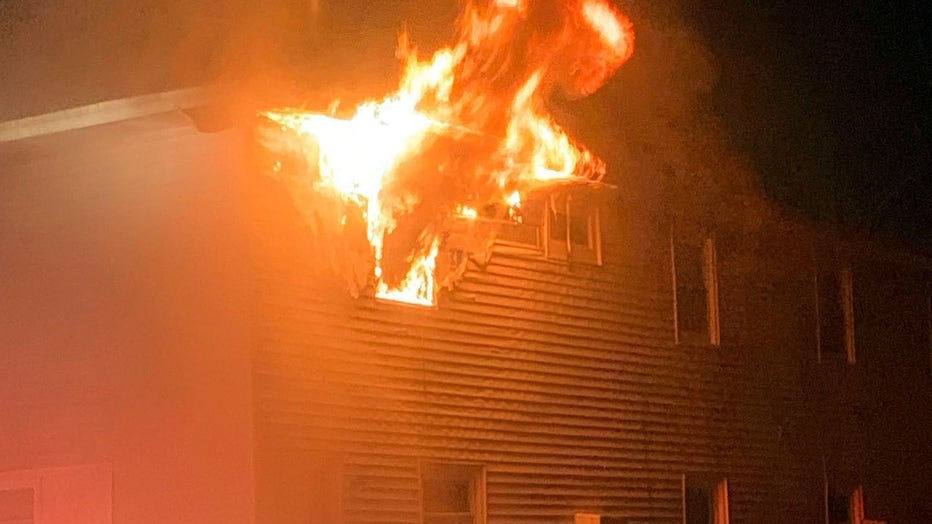
Salisbury Fire Department photo
The boy’s injuries were so minor that he did not need to be treated at the scene. His sister, meanwhile, was not hurt.
The children’s names were not released.
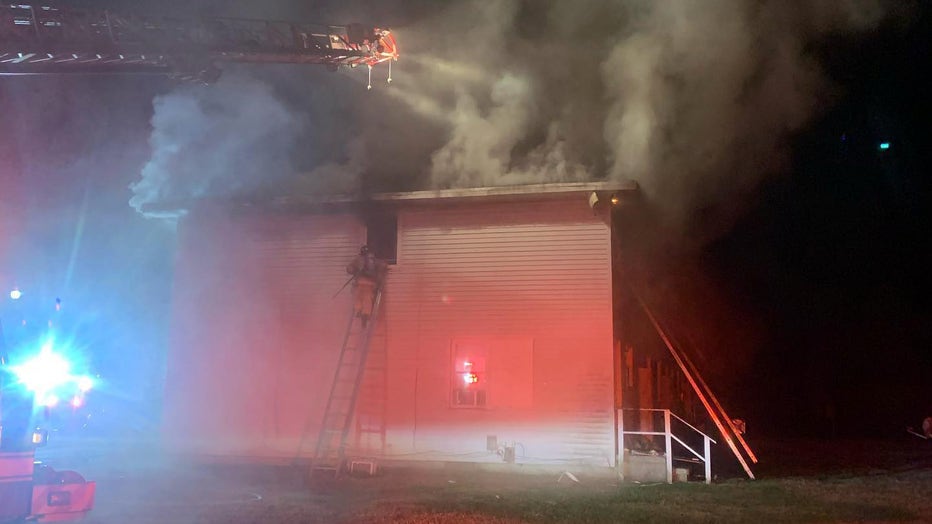
Salisbury Fire Department photo
Salisbury firefighters had the blaze under control within 10 minutes, but two of the eight apartments were left uninhabitable as a result of the fire. The Red Cross was helping the displaced residents.
Investigators ruled the fire accidental, blaming an “unspecified electrical event” in a second-floor bedroom outlet.
Recent Comments